
The first time I saw Olivia Rodrigo, she was Paige Olvera, a quirky middle schooler who started a webshow (like iCarly) with her Asian American bestie on Disney Channel’s Bizaardvark. I occasionally caught an episode here and there when I would leave Disney Channel on as background noise. I remember being impressed by the channel’s lineup then. At the time (mid-2010s), Disney Channel had several shows starring young BIPOC, rather than all-white casts like some of the shows I’d grown up with in the mid-2000s. Bizaardvark fit right in with this new library.
As avid fans of the High School Musical franchise since we were eight years old, my friends and I started following the new musical drama High School Musical: The Musical: The Series on Disney+ in 2019. There, I encountered Olivia Rodrigo again. She stars as Nini, a young, Filipino American musician with big dreams. Rodrigo even got to write two songs that her character performed in the first season!
So it was no surprise to me when “drivers license” came out back in January; I already knew who Rodrigo was. My fellow biracial Filipino American queen! But apparently the rest of the world had not caught up yet, as social media began swirling with questions about who this Olivia Rodrigo girl was, where the hell she came from, and how long would she stick around?
At the time of “drivers license” was released, Rodrigo was a relatively unknown 17-year-old, despite her years of work on Disney Channel and Disney+. “drivers license” took the world by storm practically overnight, breaking multiple Spotify records for daily and weekly streams in its first weeks post-release. Following the success of “drivers license,” Rodrigo released two more singles, then her debut album, SOUR, in May 2021. Just like “drivers license,” Rodrigo’s subsequent music releases broke more records.
As Rodrigo’s career grew, so did conversations about her online—one of the biggest topics being about her racial background. Rodrigo is half-Filipino on her father’s side and half-white on her mother’s, a fact she’s never shied away from during her Disney career; hence why I’d already been cheering her on before “drivers license” had come around!
But as Asian Americans, especially Filipino Americans, celebrated her success as a member of our community, our social media posts were often met with negativity and doubt from the rest of “stan Twitter,” the side of Twitter where the die-hard fans of artists and media franchises reside. Some people didn’t realize she was Asian American, while others outright denied her Philippine heritage because she was part-white, or as people threw around casually, “white-passing.”
The term “white-passing” is reduced to a “gotcha!” to use against mostly Asian fans of Rodrigo here, which speaks to the collective ignorance of the term and its long, complicated history in the U.S. With regards to Rodrigo specifically, her whiteness isn’t as easily recognized at first glance compared to BIPOC with other features like blue eyes or blonde hair. Additionally, many BIPOC, especially Filipinos, have pointed out that they could tell Rodrigo is a person of color from her appearance immediately.
There are ways to discuss Rodrigo’s privileges—socioeconomic, lighter skin, body shape, etc.—and how they gave her a professional advantage without obsessing over whether she’s Filipino enough or not. More importantly, the term “white-passing” is not this easily defined. Beyond phenotype (physical appearance), white-passing is an act that can be intentional. It’s about how mixed white BIPOC live their day-to-day life, the people they surround themselves with, the way they talk, the area and community they live in, and so on.
The History of “Passing”
According to the dictionary, the word “pass” is defined as moving forward; “passing,” as an adjective, can mean superficial or having a brief duration. “White” refers to the race of people who can trace their family’s origins back to Europe.
The concept of “white-passing” (sometimes simply called “passing”) originates from the history of biracial Black and white people in the U.S. In the 20th century, the “one-drop rule” in the U.S. classified anyone who had any amount of Black heritage—whether it be half, a quarter, an eighth, or even less—as Black. Because of this, especially during the Reconstruction era and the institution of Jim Crow laws in the South, “passing” became an act of survival for many biracial people. People who could pass for white could use it to travel safely, obtain better jobs, etc.
“Passing” doesn’t even mean the same thing to every BIPOC. In his book Who is Black? One Nation’s Definition, Professor F. James Davis of Illinois State University argues that the concept of “passing” specifically refers to the Black American experience:
“The black experience with passing as white in the United States contrasts with the experience of other ethnic minorities that have features that are clearly non-caucasoid. The concept of passing applies only to blacks—consistent with the nation's unique definition of the group...keep in mind that the one-drop rule and anxiety about passing originated during slavery and later received powerful reinforcement under the Jim Crow system.”
Because of this history, “white-passing” goes beyond debating whether or not Olivia Rodrigo has a pretty white girl face that made “drivers license” an overnight hit; it’s about history, intention, environment, safety, and survival. Additionally, what “white” actually looks like differs from person to person. Someone who lives in a predominantly nonwhite neighborhood in California will have a different idea of what “white” looks like compared to someone from a white suburb in the Midwest.
Well, What do “White” and “BIPOC” Actually Look Like Then?
This is a hard question to answer in 2021, as tan and dark skin have become “a trend” for white celebrities to put on and take off as they please.
Take Ariana Grande, for example, who is actually Italian American, but countless people have genuinely mistaken her for Latina—including myself years ago! She’s significantly darkened her skin since her Victorious days, to the point where she even had the same skin tone as Nicki Minaj, a Black woman, during a 2016 performance.

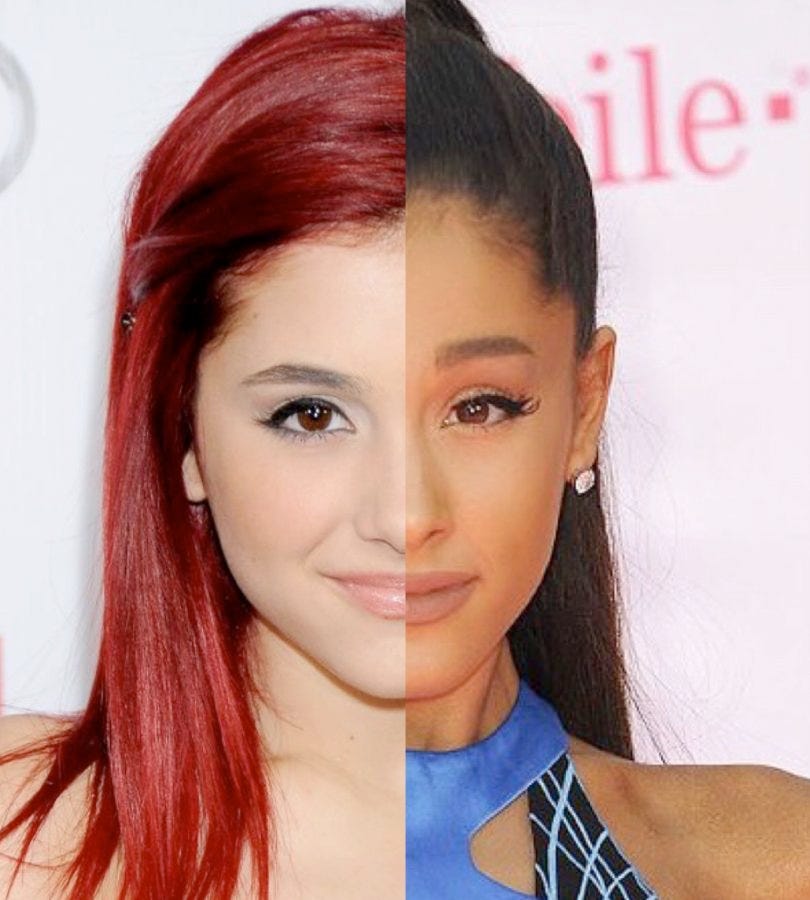
To people’s credit, as white celebrities continue to masquerade as racially ambiguous BIPOC, it’s not hard to believe they would assume someone with Rodrigo’s features may just be another ambiguous looking white celebrity. But even if Rodrigo “looks white” to some, does that mean she is inherently “white-passing”? Nothing about her career thus far has ever indicated she’s intentionally trying to pass as white or hide her Asian heritage.
Olivia Rodrigo and Her TV Characters of Color
Rodrigo’s first big break into entertainment was on the Disney Channel show Bizaardvark (2016-2019), in which she played Paige Olvera, who is implied to be Latina (her mother is played by Cuban actress Tessie Santiago), rather than fully white.

In 2017, Rodrigo participated in Disney Channel’s Asian Pacific American Heritage Month campaign, in which she shared her family’s history. She revealed her great-grandfather immigrated to the U.S. from the Philippines, making her fourth generation Filipino American. Though she’s never been to the Philippines herself, she and her family keep their traditions and culture alive at home, especially through cooking.
In a 2018 interview, she spoke further on her Filipino heritage and revealed that she auditions for roles that are open to all ethnicities. “All of the roles I’ve gotten have been all ethnicity,” she said, “which is a nice thing for casting directors to do that.”
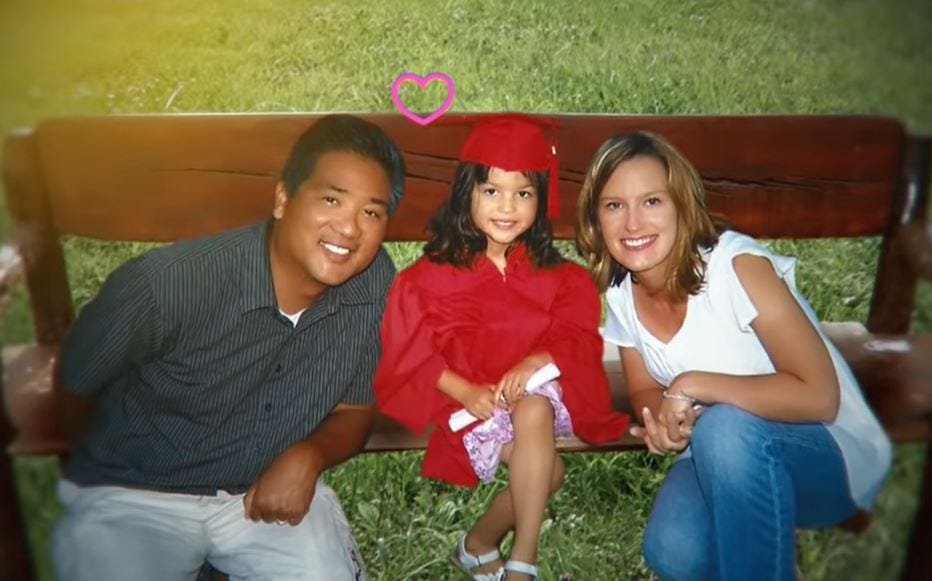
Being “Wasian” (mixed white and Asian) doesn’t always guarantee more roles for actors, especially if they have an “ethnic-sounding” last name. Chloe Bennet, former Agents of S.H.I.E.L.D. star, changed her last name to “Bennet” (her father’s first name) from her legal last name “Wang” for auditions because she struggled to book roles as Chloe Wang, despite her successful music career in China as a teenager. Once her name on paper became Chloe Bennet, Bennet says she saw an immediate change: “The first audition I went on after I changed my name, I got booked. So that’s a pretty clear little snippet of how Hollywood works.”
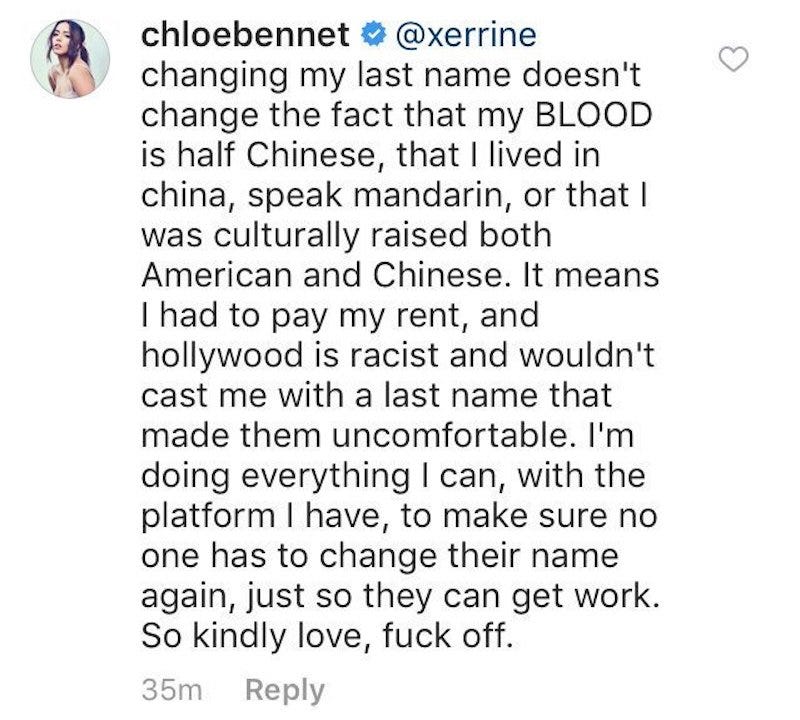
At that time, Bennet had reached a point where she genuinely needed work to pay her rent, hence resorting to her name change in order to be cast. This is an example of intentionally trying to pass as white, though Bennet is often loud and proud about her Chinese American heritage on social media and has participated in Asian American activism efforts.
Currently, Rodrigo’s Filipino heritage is on full display in her current project, High School Musical: The Musical: The Series (2019—) on Disney+. She plays Nini Salazar-Roberts, who has a Filipino grandmother named Malou who she calls “Lola” (the Tagalog word for “grandma”). In the episode “Thanksgiving,” Malou also tells Nini the story of her immigration to the U.S. from the Philippines.
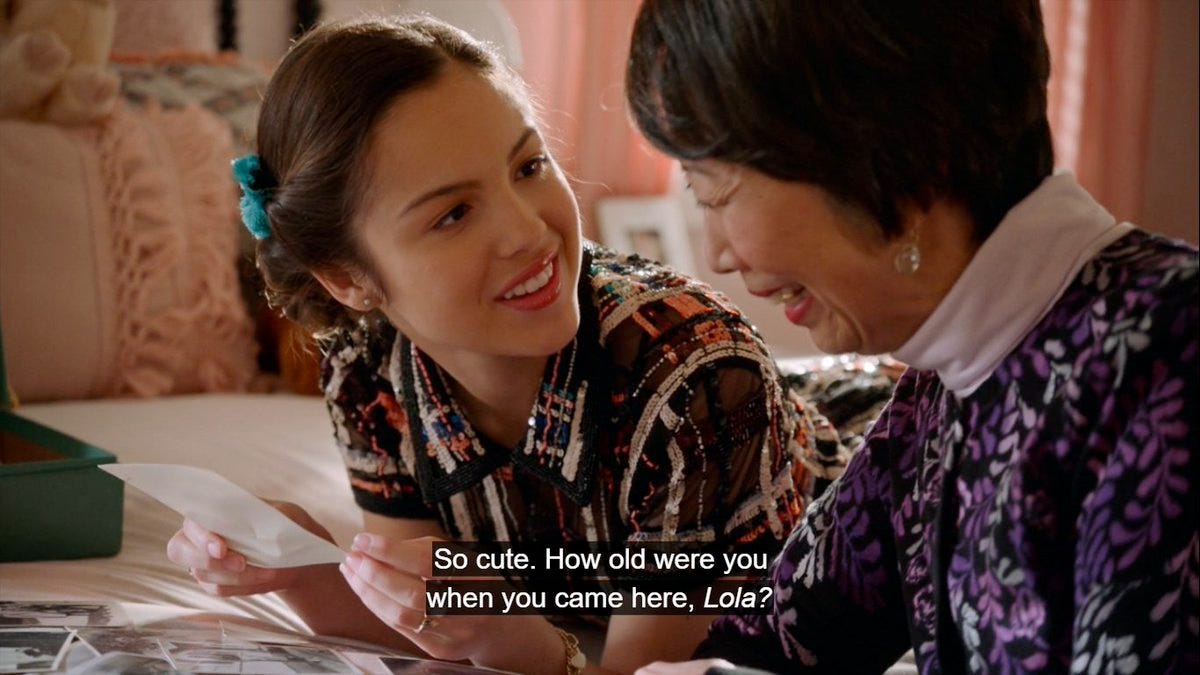
“I hate the way I’m perceived”: Olivia Rodrigo’s Race and Her Music Career
Rodrigo’s music explores her experiences as a teenage girl in the late 2010s, notoriously focusing on a former partner who left her for someone else who happens to be white. Her biracial heritage adds a lot of context to her lyrics, as she often laments over the physical differences between herself and her ex’s current white partner.
In “drivers license,” she mentions the insecurities she feels compared to her ex’s new partner:
“And you’re probably with that blonde girl
Who always made me doubt
She’s so much older than me
She’s everything I’m insecure about.”
The rest of SOUR develops this experience further, painting a clear picture of a young woman of color whose white partner left her for a white woman.

A lot of Rodrigo’s lyrics on SOUR have resonated with BIPOC, especially young women, even if they are not explicitly about race.
For example, in “jealousy, jealousy,” Rodrigo reflects on how often she compares herself to other women, especially on social media:
“I kinda wanna throw my phone across the room
'Cause all I see are girls too good to be true
With paper-white teeth and perfect bodies…
I know that beauty is not my lack
But it feels like that weight is on my back
And I can't let it go
Com-comparison is killin' me slowly.”
It’s difficult to feel beautiful in a society that upholds Eurocentric beauty standards as a woman of color, and Rodrigo is no stranger to this feeling. In an interview with The Guardian shortly before SOUR’s release, she said:
“It’s hard for anyone to grow up in this media where it feels like if you don’t have European features and blonde hair and blue eyes, you’re not traditionally pretty. I felt that a lot—since I don’t look exactly like the girl next door in all these movies, I’m not attractive. That actually took me a while to shake off. It’s something I’m still shaking off now.”
Between SOUR’s success, her subsequent performances, and the second season of High School Musical: The Musical: The Series, Rodrigo’s music career continues to grow. However, she has also ended up in conflict with some of her white contemporaries in the business.
After announcing SOUR Prom, her concert film for the album, Courtney Love, a 57-year-old white woman, accused Rodrigo of copying Hole’s (Love’s band) Live Through This album cover in her SOUR Prom promotional picture and proceeded to harass Rodrigo on social media.
Nearly two months after the release of SOUR, Rodrigo’s team abruptly gave writing credit to Taylor Swift and several other white songwriters on “deja vu,” after Rodrigo had said she took inspiration from the bridge of Swift’s “Cruel Summer” multiple times. (It’s not clear who between Swift and Rodrigo’s teams initiated adding this writing credit.) This also comes after months of repeated harassment from predominantly white Taylor Swift fans who allege Rodrigo is using her admiration for and friendship with Swift for clout.

Rodrigo’s treatment by everyday consumers of music and other professionals in her industry from “drivers license” to now beg the questions: if Rodrigo was fully white, or a white man, what would be different? Would she receive the same scrutiny or obsession over her body, family, and blood? Would she be allowed to claim full ownership of her art without being pressured to credit other white women?
Fortunately, Rodrigo seems publicly unbothered by it all, and strives to use her platform for good—most recently by visiting the White House to meet with President Biden and Dr. Anthony Fauci to discuss using her platform to encourage more young people across the country to get vaccinated.
Rodrigo undoubtedly benefits from her privilege of having light skin and some racially ambiguous features; but to call her “white-passing” specifically to deny her Philippine heritage, to accuse Rodrigo of intentionally erasing her own heritage, or to tear down BIPOC fans celebrating her, is ignorant and performative. It does not aid or benefit BIPOC in any way.
Olivia Rodrigo is the most relatable artist I’ve come across in a while, as a third generation, half-white, half-Filipino American myself; her experience is about as close as it gets to my own. I’m so proud of her. And I can’t wait to see what she does next.
Did you know Olivia Rodrigo is Filipino? What are your favorite songs from SOUR? (I’m still a “drivers license” stan, personally.) Let us know in the comments below! Thank you!
To further educate ourselves on the history of passing and the mixed race experience:
Medium | I’m a black man with white privilege. I see how it distorts America by Steve Majors
Medium | Mixed race identity: A reading list by Alex Sujong Laughlin
The Queens Journal | Recognizing being white-passing as a privilege by Hareer Al-Qaragolie
The Vanishing Half by Brit Bennett
When Half Is Whole: Multiethnic Asian American Identities by Stephen Murphy-Shigematsu
If you liked what you read, be sure to subscribe above and follow us on Twitter and Instagram @invisibleasians to stay updated on Politically Invisible Asians!




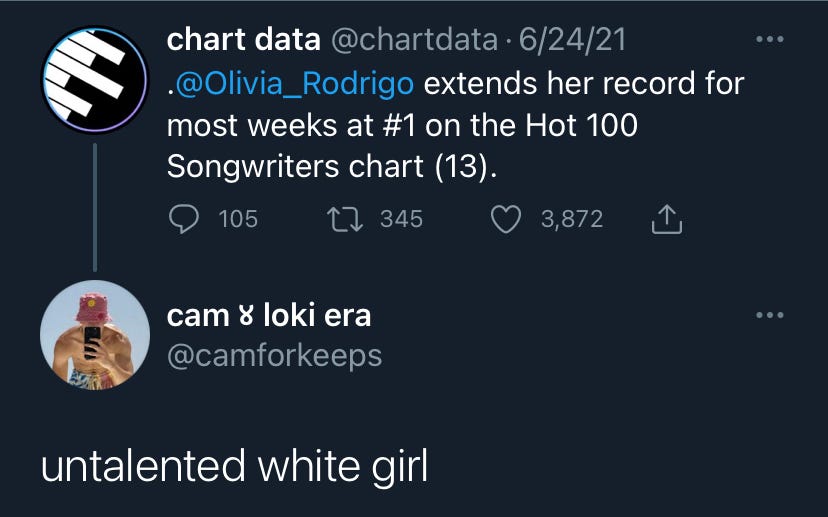

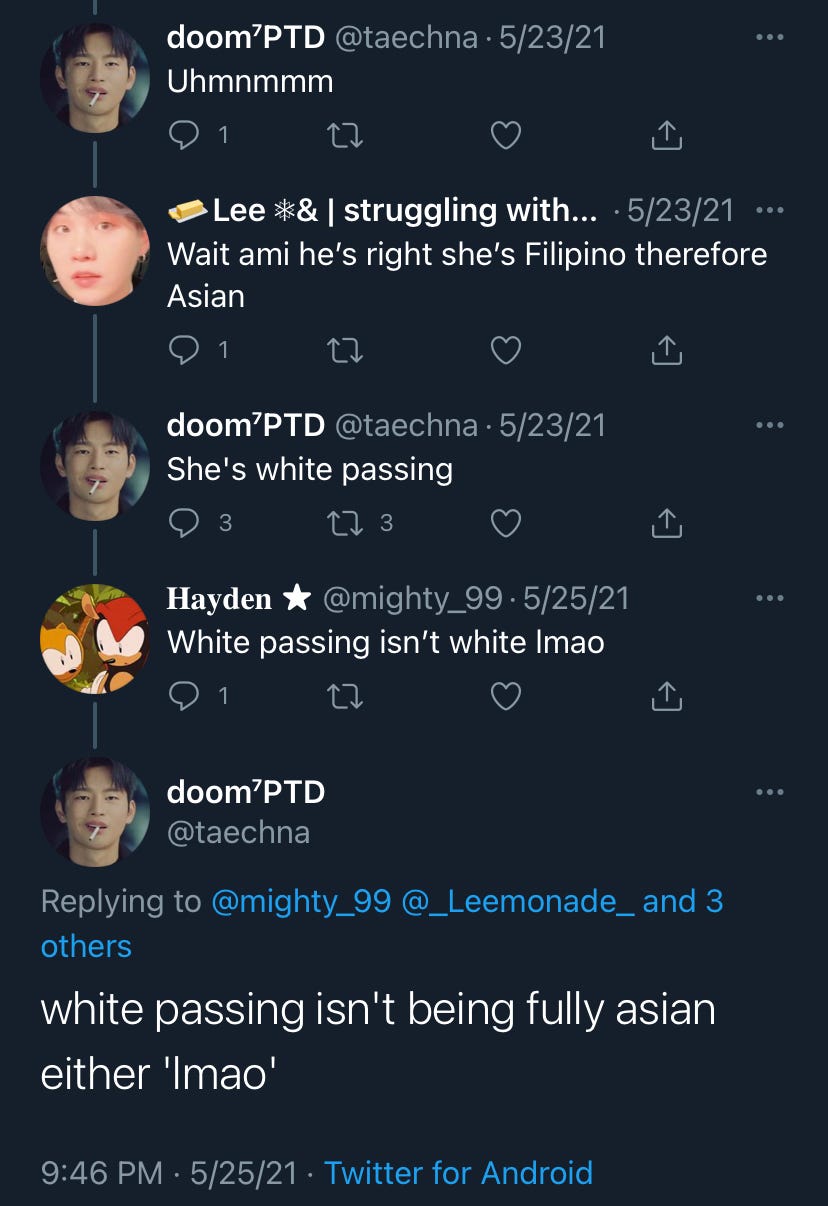
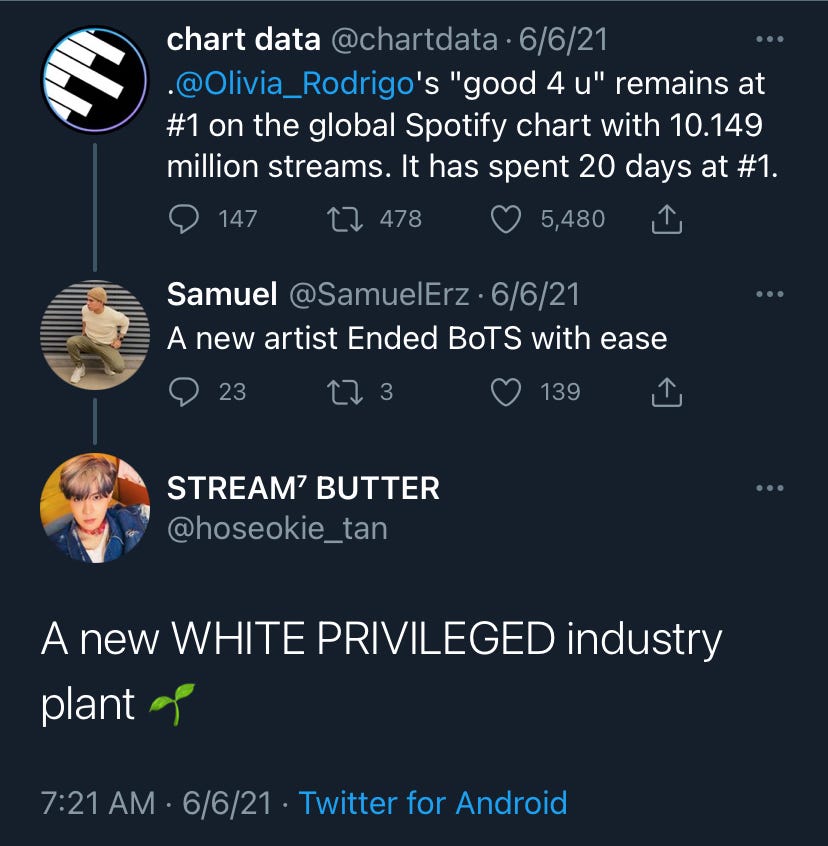
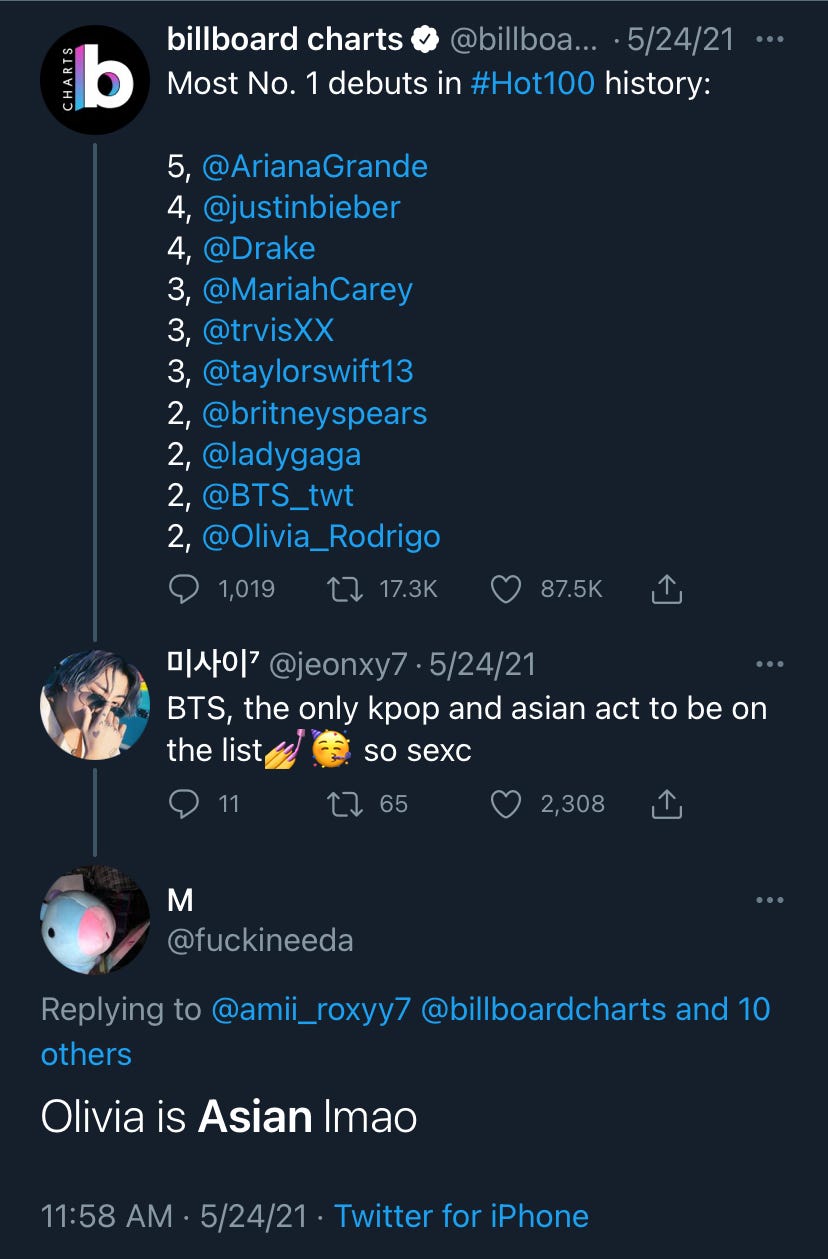

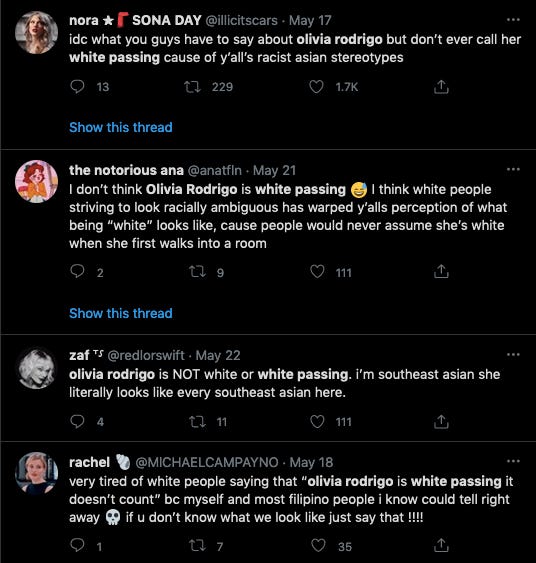

Very well written. I listen to “good 4 u” at least once a day. Olivia is such a gift!
This is old, but wtf? Half filipina is not even close to the same thing as full Filipina. We know this because half Filipina in hollywood are not new, and the only Filipinos who make it big, or only part filipino